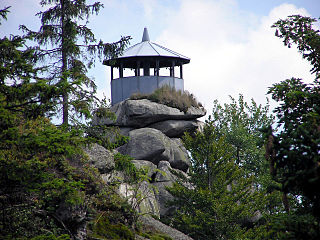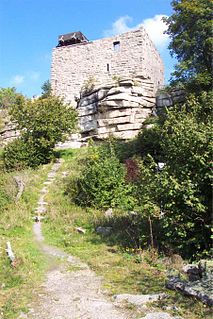
The Fichtel Mountains, form a small horseshoe-shaped mountain range in northeastern Bavaria, Germany. They extend from the valley of the Red Main River to the Czech border, a few foothills spilling over into the Czech Republic. They continue in a northeasterly direction as the Ore Mountains, and in a southeasterly direction as the Bohemian Forest. The Fichtel Mountains contain an important nature park, the Fichtel Mountain Nature Park, with an area of 1,020 square kilometres (390 sq mi).

The Rhön Mountains are a group of low mountains in central Germany, located around the border area where the states of Hesse, Bavaria and Thuringia come together. These mountains, which are at the extreme southeast end of the East Hesse Highlands, are partly a result of ancient volcanic activity. They are separated from the Vogelsberg Mountains by the river Fulda and its valley. The highest mountain in the Rhön is the Wasserkuppe which is in Hesse. The Rhön Mountains are a popular tourist destination and walking area.
Hohe Warte may refer to the following geographical locations:

A Mittelgebirge is a relatively low mountain range or highland area, a typical geographical feature of Central Europe, especially Central and Southern Germany; it refers to something between rolling low hill country or Hügelland and a proper mountain range like the High Alps.
The Thuringian-Franconian Highlands are a natural region of Germany which is designated as D48 or 39 by the BfN. It consists mainly of a ridge of mountains up to just under 1,000 m high between the Central Upland areas of the Thuringian Forest, Thuringian Slate Mountains, Franconian Forest and Fichtel Mountains, and which runs from west and south Thuringia through Upper Franconia and southeast to just before the Czech border and the so-called Bohemian Massif.
The Saxon Highlands and Uplands refer to a natural region mainly in the south of Saxony with small elements also in southeast Thuringia and northeast Bavaria. It comprises, from (south)west to (north)east, of the Vogtland, the Ore Mountains, Saxon Switzerland, the Upper Lusatian Plateau and the Zittau Hills.

The Fichtel Mountain Nature Park lies in the tri-border area of Saxony, the Czech Republic and Bavaria and has an area of 1,020 km2 (390 sq mi). It is maintained by the Naturpark Fichtelgebirge e. V. in Wunsiedel.

The Platte is a summit, 885 metres (2,904 ft) high in the Fichtelgebirge in central Germany. It is located between two other elevations, the Seehügel and the Hohe Matze, half way between the Ochsenkopf and Kösseine mountains, on the Rhine-Elbe watershed.

The Ochsenkopf is the second-highest mountain in the Fichtel Mountains with a height of 1,024 metres (3,360 ft). On its summit is an observation tower and a transmission tower for VHF and TV programmes by Bayerischer Rundfunk.

The Fichtelgebirge Club is a large walking club and local heritage society in Bavaria and recognised conservation group with 20,000 members in 55 local groups. As the name says, its main sphere of activity is in the Fichtelgebirge mountains in north Bavaria. Its emblem is the Arctic starflower.

The Kösseine is a massif in the High Fichtel mountains in Germany, lying in northeast Bavaria south of Wunsiedel. The highest elevation of this granite massif is the summit of the Große Kösseine, 939 m above sea level (NN). The border between the Bavarian provinces of Upper Franconia and Upper Palatinate runs over the Kösseine as does the European watershed between the North Sea and the Black Sea. Around the Kösseine are the settlements of Wunsiedel, Marktredwitz, Bad Alexandersbad, Waldershof, Hohenhard, Neusorg, Brand, Ebnath, Nagel and Tröstau, tourist resorts within the Fichtelgebirge.
On the Kösseine rises an eponymous stream, which flows through Waldershof and Marktredwitz before discharging into the Rösla, a tributary of the Eger, near Seußen.

At 972 m above sea level (NN) the Nußhardt is the third highest mountain in the Fichtel Mountains in the south German state of Bavaria. It lies in the far northeast of the state and has a rocky summit characteristic of the Fichtelgebirge. The summit area with its felsenmeer and tor is a nature reserve with an area of 5.5 hectares. In addition the Nußhardt is incorporated into the geotope register of the Bavarian State Geological Department under No. 472R013.

The Steinwald is a mountain range up to 946 m above sea level (NN) in southern Germany and, at the same time, a nature park founded in 1970 with an area of 246 square kilometres (95 sq mi) in the province of Upper Palatinate, in North Bavaria.

The Großer Waldstein is part of the Waldstein range in the Fichtel Mountains of Germany. It is known primarily for its rock formations caused by spheroidal weathering, its ruined castles and the only remaining bear trap (Bärenfang) in the region.

The Waldstein is a mountain range in the northern part of the Fichtel Mountains in Upper Franconia, Bavaria, in southern Germany.

The Epprechtstein is a mountain in the northern Fichtel Mountains in northeast Bavaria, 798 m above sea level (NN). It is mineralogically the most interesting mountain in the entire Fichtel range. Around the summit there are about 20 quarries, in three of which Epprechtstein granite is quarried. The others are closed and partially overgrown.

The Höllpass is a 683 m high mountain pass in the northern part of the Fichtel Mountains in Bavaria, Germany.

The Bergkopf is an 857 metre high, thickly forested mountain in the Sparneck Forest in Germany's Fichtel Mountains.
The Upper Palatine-Upper Main Hills, also called the Upper Palatine-Upper Main Hills and Uplands form a landscape of low, rolling hills between the Franconian Jura in the southwest and the Franconian Forest, Fichtel Mountains and Upper Palatine Forest in the northeast.



















